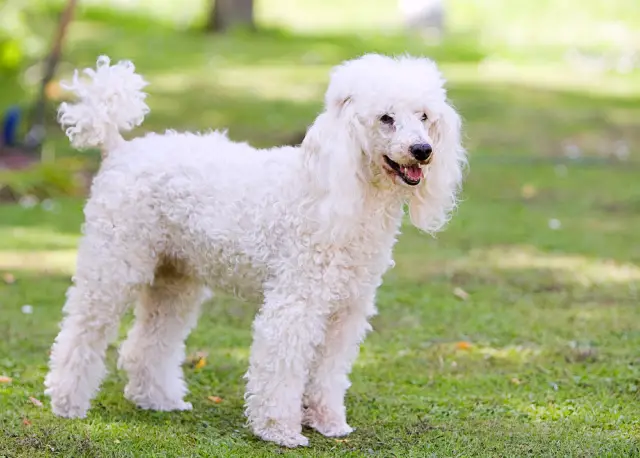Are you considering getting an Aussiedoodle, also known as an Aussiepoo? It is only natural to wonder just how long these breeds tend to live as this can affect the number of years you should be prepared to commit to the dog. So, what is the average life expectancy of an Aussiedoodle dog?

How Long Do Aussiedoodles Live For?
The life expectancy of an Aussiedoodle varies with size, generation, and many other factors. Standard Aussiedoodles live to about 10 to 13 years of age while Miniature, or Mini, Aussiedoodles live slightly longer at 12 to 15 years. Toy Aussiedoodles live the longest, although they rarely exceed 15 or 16 years.
Let’s look at how genetics plays a role in the lifespan of an Aussiedoodle, and how size as well as other factors can affect their longevity.
Related: Aussiedoodle Temperament Guide: Australian Shepherd Poodle Mix
Genetics of Aussiedoodle Life Expectancy
Poodle Life Expectancy

Poodles make up half of the Aussiedoodle’s genetics, so it is important to consider the average lifespan of a Poodle.
Poodles come in several sizes. The larger Poodles, known as Standard Poodles, live around 12 to 15 years. As the size decreases, the lifespan of the dog increases.
Miniature Poodles live to be around 15 years, and some Toy Poodles can live to slightly above 15 or 16 years, rarely more.
This pattern of increased size leading to decreased lifespan is true for most dog species.
Australian Shepherd Life Expectancy

Australian Shepherds, which make up the other half of the Aussiedoodle, have a similar lifespan to Poodles, at least when comparing the standard size.
Standard Australian Shepherds live for roughly 13 – 15 years.
The difference in lifespan can be seen in the smaller sizes where the Miniature Australian Shepherd, officially called the Miniature American Shepherd, and the Toy Australian Shepherd both rarely exceed 15 years of life.
The smaller sizes do tend to push the upper extremes, edging closer to 15 years of age, while the standard size usually lives closer to 13 years.
Aussiedoodle Life Expectancy Based on Genetics and Size

When comparing the genetics of the Australian Shepherd and the Poodle, we can see that the Aussiedoodle should live to about 13 years, if they lead a healthy lifestyle.
Due to the compounding of some hereditary issues that both the Poodle and Australian Shepherd experience, some may live a slightly shorter life at around 10 years.
Like the parent breeds, smaller Aussiedoodles live longer. Mini Aussiedoodles can be predicted to live between 12 and 15 years when combining the expected lifespans of the Poodles and Australian Shepherds, and Toy-sized Aussiepoos may even live to be older than 16, although it would be rare for them to exceed 16 by a lot.
Why Do Smaller Aussiedoodles Live Longer

Toy Aussiedoodles live longer than Mini Aussiedoodles, which live longer than Standard Aussiedoodles. But, why is this the case?
We live a lot longer than animals that are a lot smaller than us, so why does this suddenly matter in dogs?
Although the reason for this is not perfectly clear, some predict that it is because large dogs seem to age at an accelerated pace. There is also the possibility that because their cells replicate so quickly they are more prone to certain cancers.
A lot more research needs to be done in the field before anyone can say anything with certainty though.
Does Generation Affect Aussiedoodle Life Expectancy

The short answer is, yes. The lifespan of an Aussiedoodle can theoretically be improved with hybrid vigor.
This is where the good, strong characteristics of both parent breeds are amplified in the first-generation hybrid.
As you continue breeding with your hybrid dog, the effects of that hybrid vigor will be reduced.
F1 (First generation) Aussiepoos have the greatest hybrid vigor. It is then reduced, but still present in F2 (Second generation) Aussiedoodles.
By the time you get to the third generation or F3 Aussiedoodles, hybrid vigor is practically non-existent.
Related: Aussiedoodle Generations Explained | Do Aussiedoodles Have a Tail? Answered!
Health Issues that Affect Aussiedoodle Life Expectancy

The life expectancy numbers listed above are nothing more than averages. Your Aussiedoodle may lead a very healthy lifestyle and exceed them slightly, or they may not reach even the lower number of the age bracket.
Let’s look at some health conditions that the Aussiedoodle is prone to which might reduce its life expectancy.
For the sake of simplicity, I’ll only delve into health issues that both Poodles and Australian Shepherds are prone to as they are more likely to be expressed and amplified in your Aussiedoodle.
Hip and Elbow Dysplasia
Hip and elbow dysplasia are common in both Australian Shepherds and Poodles. This means that if your breeder did not have the parents tested, your Aussiedoodle might be at extreme risk of these issues.
Hip and elbow dysplasia can greatly affect your Aussiedoodle’s mobility and can cause your dog a great deal of pain. If this is the case, it might get to the point where the vet recommends putting the dog down.
Additional issues may develop as a result of the lack of mobility.
Epilepsy
Both Poodles and Australian Shepherds are prone to epilepsy. Sometimes there is nothing that can predict it and nothing that can be done to cure it.
If your Aussiedoodle suffers from epilepsy, it is at risk of brain damage. This is particularly true if your Aussiepoo suffers from multiple seizures in a row, also known as cluster seizures, or suffers from particularly strong seizures.
Double Merle
Double Merle, also sometimes known as Killer Merle, is what happens when you breed two merle dogs together. This probably won’t occur in a first-generation Aussiedoodle. But it may occur when breeding two merle Aussiedoodles together, or a merle Aussiedoodle with a merle Australian Shepherd.
In cases like this, puppies may live a full and healthy life, or they may be affected by other health conditions. These can include seizures, blindness, loss of hearing, etc. All of this can put them at risk of injury and death.
They are also incredibly susceptible to skin cancers due to their pale coloration. Skin cancers are also prevalent in Poodles, which only adds to the likelihood of it appearing.
How to Give Your Aussiedoodle a Long and Healthy Life

Although there is not always anything that we can do to prevent illness or injury, there are some things that we have control over which may influence your Aussiedoodle’s lifespan.
Adequate Exercise
Not getting enough exercise can influence your Aussiedoodle’s health. Not only can it lead to depression and anxiety, but also weight gain.
Lack of exercise and stimulation may also cause an increase in destructive tendencies. This means your Aussiepoo may eat something it shouldn’t.
To prevent boredom, consider getting a toy that your Aussiedoodle can play with when you are busy.
Also, ensure that you give it daily exercise.
Related: Do Aussiedoodles Like Swimming? Answered!
Nutrition
Good food can promote healthy joints. If your Aussiedoodle already has a predisposition to joint issues such as dysplasia, you may not be able to prevent it. However, you may be able to help reduce inflammation and delay the onset of symptoms.
In my experience, changing to a better food like this one, along with joint supplements, can have a positive effect on your dog in a matter of days. The changes may be small, but it is the difference between your Aussiedoodle barely being able to get up, to walking around the backyard quite comfortably.
It is best to consult your vet regarding dog food as each dog is different. However, some dog foods are designed specifically with joint health in mind.
Related Reading:
- Is a Male or Female Aussiedoodle Better?
- How Big Will An Aussiedoodle Get (Size and Weight)
- Do Aussiedoodles Bark A Lot? Answered!
- Why Does My Aussiedoodle Smell? (And How to Make it Smell Better!)
- Aussiedoodle Coat Types And How To Care For Them
- Are Aussidoodles Hypoallergenic: Do They Shed?
- Are Aussiedoodles Protective: Do They Make Good Guard Dogs?
